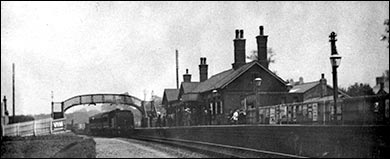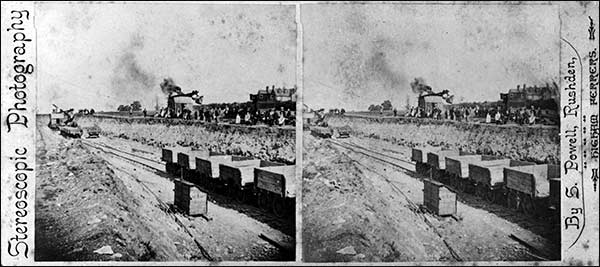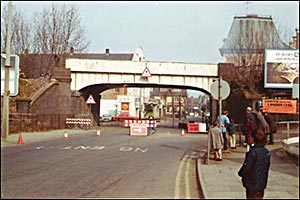In December 1888 a railway branch line from Wellingborough to Rushden & Higham Ferrers was proposed by some businessmen in the area who were unhappy with the existing railway links. The boot and shoe trade especially was fast increasing and regular supplies were required for the manufacturing. There was of course also a need to transport the finished goods with the minimum of delay. The closest stations at that time were at Irthlingborough and Irchester, some distance from the town.
The Midland Railway were asked to consider a loop line through Rushden & Higham Ferrers to the station at Raunds, which was on the line from Kettering to Cambridge. Fortunately, Midland Railway recommended the proposition to their shareholders which was accepted and their plans were published in April 1889. The original plan was later revised so as to include a station at Higham Ferrers. Following the acceptance the proposals were submitted to Parliament and the act received Royal Assent on 25th July 1890.
|
Rushden Argus 9th October 1891
|
| MIDLAND RAILWAY – Mr. Ainsworth, an engineer of the Midland Railway Company, attended with plans of the new railway station which showed it as situate in the field adjoining Mr. Mason’s farmhouse. The station itself would be on the site of the footpath from the Backway to North Street while it would be approached by a 25ft. road at an interval of about 12 ft. beyond the line of the old houses. The plans, with the suggestion that a footpath should also be constructed (which were acceded to) were approved. |
|
Rushden Argus 12th August 1892 report
|
| THE NEW LINE – The Engineers report for the half-year says that the Irchester & Higham Ferrers branch is more than half done and will be completed early next year. The expenditure for the half-year ending June has been for land £2000; for construction of line £10,156 2s 10d; and for law and Parliamentary charges £151 11s; making a total expenditure for the six months ending June 30th 1892 of £13,047 3s 4d. |
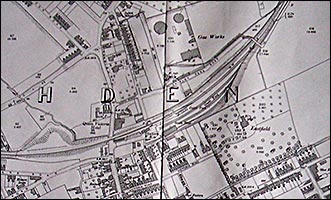 |
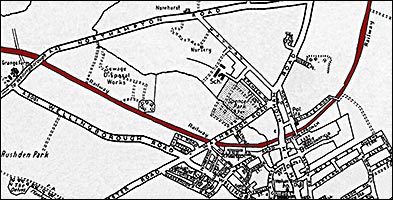 |
|
Maps showing the railway in Rushden; left in 1900, right in 1901
|
|
| There was no time to lose and so construction of the line was started in early 1892 under the general control of Walter Scott & Co. of Newcastle. The Chief Engineer was Mr A.E. Ainsworth and erection of both Rushden and Higham Stations was undertaken by Mr. Parnell of Rugby. The whole construction took eighteen months using an average of four hundred workmen. The track layout which was at Higham Ferrers seems to indicate that the Midland Railway intended to complete the line up to Raunds, as the running line was extended well beyond the run-round loop and goods shed connection as far as Kimbolton Road. It is reported that the line was only completed as far as Higham as a local landowner refused to sell the land needed for the track. It would seem that he also built row of cottages across proposed path so that no future extension could be undertaken. |
Due to the refusal of the landowner to make the land available the line was now destined to be just a short branch line. Therefore, only one track was laid although all the bridges and cuttings were constructed to allow a second track to be laid if later negotiations to purchase the land were successful. This did not come about so it can only be assumed that either negotiations were never started or an agreement was not reached and so the plan was presumably abandoned. The length of the line from Wellingborough to Higham Ferrers was 5 ¼ miles.
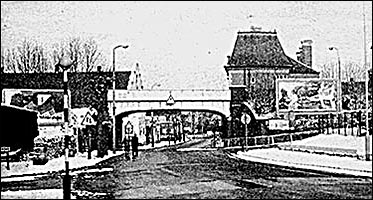 |
The bridge over the High Street
|
|
On 1st September 1893 the line was opened to goods traffic for bringing coal to Rushden for local use. On 9th March 1894 the route was then inspected by Major H. A. Yorke, RE of the Board of Trade.
Two coupled engines made several runs over the road bridge crossing the High Street near Rushden Station to test for safety and it was approved for opening to passenger traffic.
|
| Following the approval the first passenger service ran from Higham Ferrers on 1st May 1894. Large crowds gathered at the station, on the bridges and on the embankments. Some even climbed trees and people cheered at the arrival of the two Midland Railway trains: 0-6-0 No. 212 was driven by Mr. Glover and 0-4-4 No. 2022 was driven by Mr. Fred Seal. It was reported that the Station Master, Mr. A. Roper, discharged his duties in a cool, calm and collected, yet diligent manner. The train departed at 7.45am which was five minutes late. When the train stopped at Rushden Station the station approach was packed with high-spirited crowds and people clustered near the track according to a newspaper report at the time. The Station Master at Rushden was Mr Henry Pitt and the fare on the day from Rushden to Wellingborough was 4d and from Rushden to Higham was 1d. Children could go from Rushden to Higham for ½d and hundreds of people took the opportunity to take their first ride. |
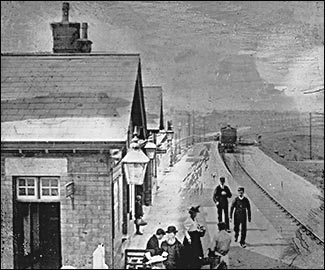 |
|
Rushden Station
|
|
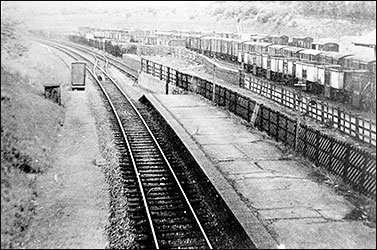 |
 |
 |
 |
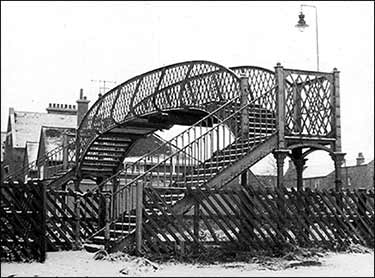 |
These five pictures from the late Colin Bryant's Collection
The Sidings
Repainting the Letters
Delivery Lorry
Gangers Outing
The Foot Bridge and Lamp
The Old Police Station far left
|
| In the early days Station Approach was a gated road with no connection to Beaconsfield Terrace and Rectory Road and goods arriving at the station were delivered to the local tradesmen by horse and cart. The railway dray horse stables were situated on the corner of Station Road and High Street, opposite the bottom of Station Approach, where Cyril Freeman’s garage (demolished in 2008) was built in the 1950s. |
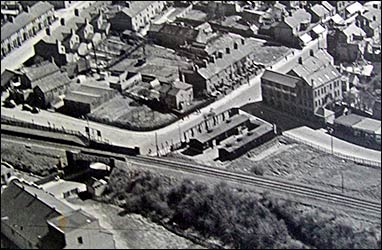 |
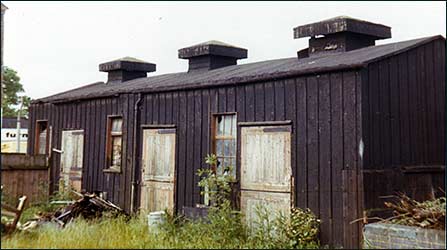 |
|
1950s aerial photo showing the track, bridge and stable blocks
|
|
|
|
|
Steroscopic Photograph by Samuel Powell.
It shows the main Rushden to Higham Ferrers line.
In the background (far right of picture) is Eastfields, home of the Denton family.
|
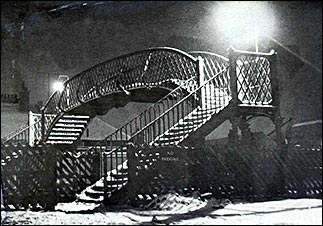 |
|
The footbridge at night and by day (below)
|
 |
|
|
Kelly's Directory 1903
|
Stationmaster
|
Henry Pitt
|
|
Kelly's 1920 & 1924
|
Stationmaster
|
John C Gregory
|
|
| The station was well used in its early years especially for the boot and shoe trade as its products were taken from there for export abroad, and to other parts of this country. |
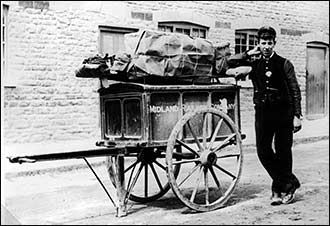 |
|
Midland Railway hand cart for deliveries in town
|
|
Eventually the Midland and London and North Western Railways were merged to become the London Midland and Scottish Railway. In 1921 a third class season ticket to travel between Wellingborough & Rushden was 13s 8d. In the 1920s goods traffic was abundant but decreased during the depression with many shoe firms already starting to decline with short time working. In addition old fashioned ways, out-dated machinery and poor management led to the gradual fall of the industry. Many small firms went out of business. Investment by John White in buildings, plant and machinery improved the trade somewhat and the recovery from the depression was well underway when World War Two broke out. By the end of the war the railway was worn out and services and supplies depleted. During the war several bombs fell close to the Station, on the Queen Victoria Hotel and Shirley Road. It is not known if the bombs were meant for the railway line but if they were they were unsuccessful.
| In 1948 the railways were nationalised and British Rail came into being, and two years later the last horse drays were replaced by lorries. In the early 1960s Dr. Beeching was appointed as head of British Rail and began his famous ‘cull’ of the railways in order to make them more cost effective. The line to Higham Ferrers was designated for closure and despite protests and petitions Rushden & Higham Ferrers Stations were closed to the public on 13th June 1959 with the withdrawal of passenger services apart from the traditional August Bank Holiday excursions which carried on until 1964. Crowds turned out to witness the passing of an era many taking a final trip on the line, the fare was 3d return to Higham Ferrers and Rushden. Goods trains still used the line, then the goods depot closed at Higham Ferrers the station there followed suit on 3rd February 1969 with Rushden closing later in November 1969 with closure of the coal depot. |
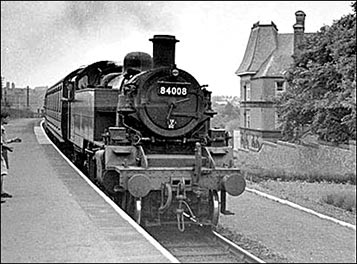 |
|
1959
|
|
Higham Station was demolished and Rushden station, unoccupied and deserted became almost derelict. As it was no longer needed and its removal meant high vehicles could now traverse the length of the High Street without the need for diverting round the town, the Railway bridge over the High Street was demolished in 1973.
In 1976 the Rushden Historical Transport Society was founded by a small group of people. In 1984 there was an opportunity to acquire a lease on the derelict Rushden Station and the society obtained recognition as a Charitable Organisation. An enormous amount of voluntary effort by some of the society members has brought the station back to pristine condition. In 1985 a museum was opened in the goods and parcels offices and a very popular real ale bar in the old ticket office and ladies waiting room. In 1987 the station was threatened with demolition to make way for a new road development but the threat was lifted in 1990 and in 1996 the station freehold lease was purchased from Northamptonshire County Council. Link to www.rhts.co.uk
|
